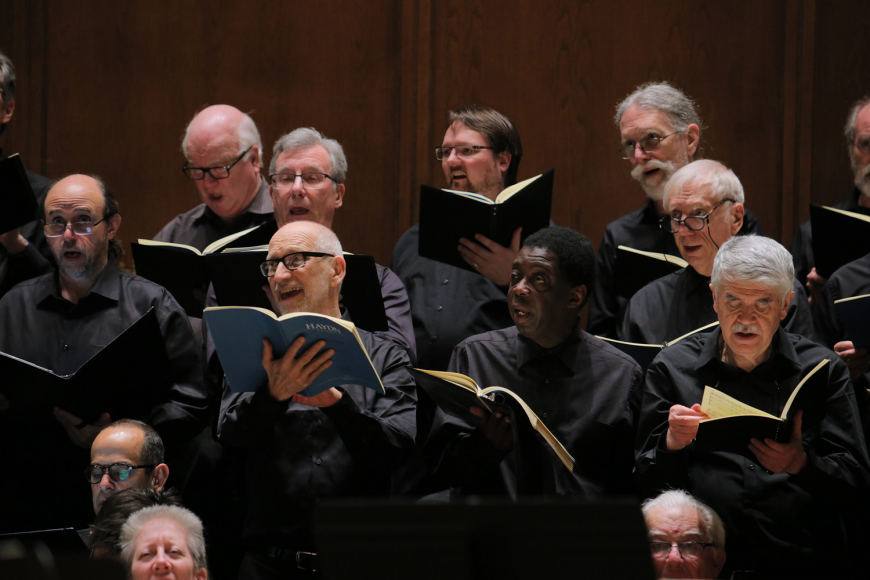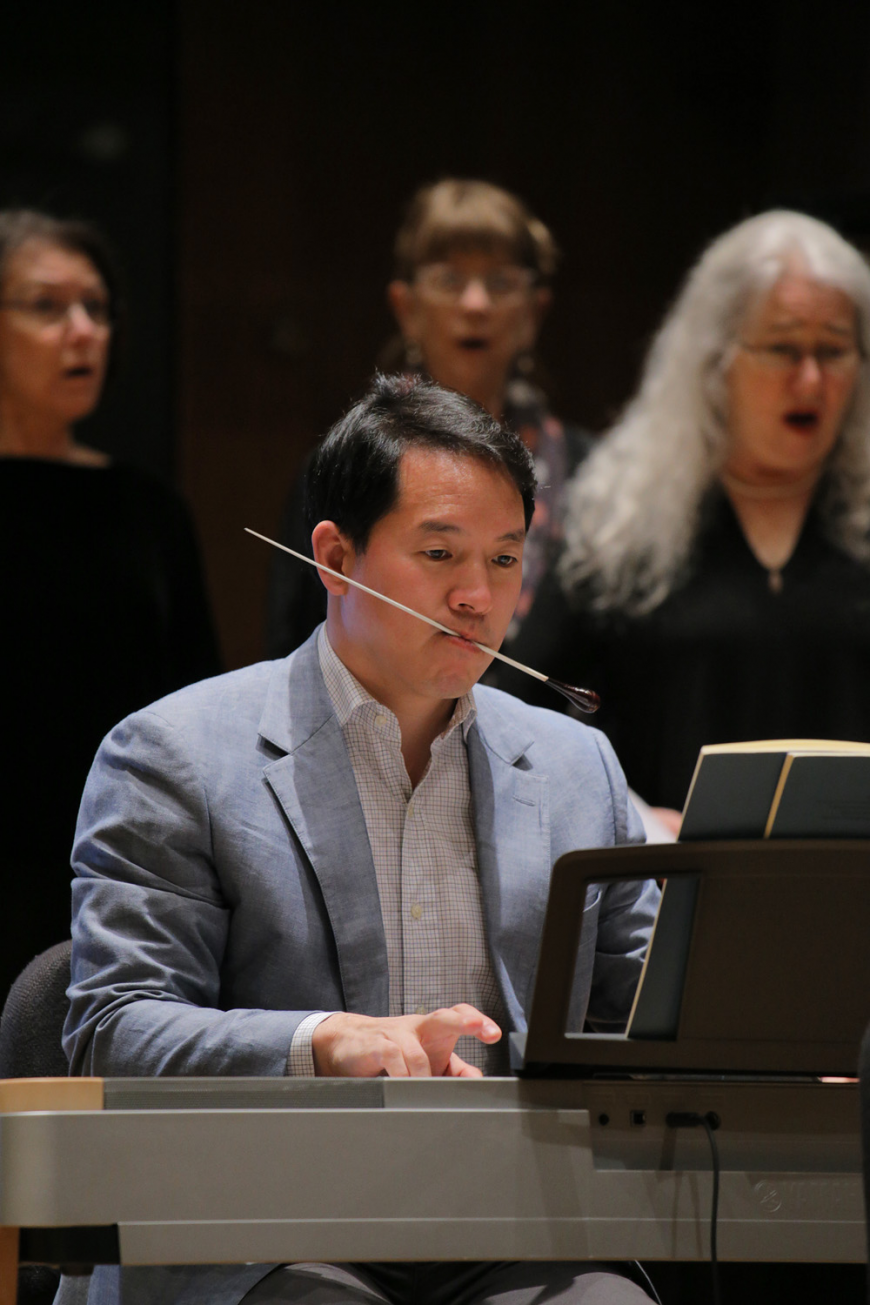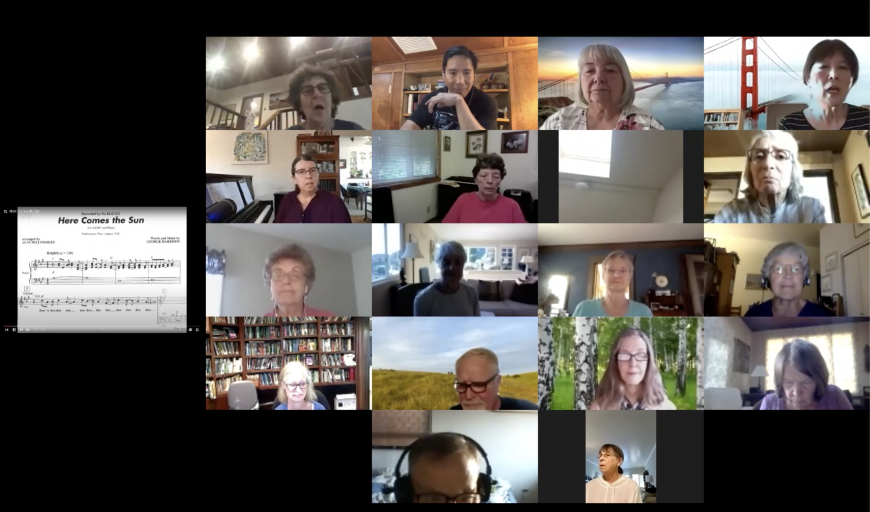
For over half a century, Berkeley Community Chorus and Orchestra excelled with enthusiastic, loyal members, great concerts, and acclaimed tours, and not even the pandemic could finish BCCO off.
But as singing together is the heart and raison d’etre of a chorus, working remotely for the past year and a half has tested BCCO greatly, reducing membership even as the majority continued rehearsals without being in the same space.
“Singing remotely has forced me back on my own resources,” says Janice Murota, a BCCO board member, who has been the group’s volunteer publicity manager for a decade. “It tested my resolve to sing well/accurately/learn the music.
“As always if I know my part well, I love singing alto along with the bass. I listen to a full chorus recording and sing ‘against’ that sound. The music is still glorious. I so appreciate the intricate vocal lines of the great composers. [I] love the challenge that persists for the lone singer even on Zoom.”

BCCO Music Director Ming Luke adds: “The pandemic forced us to reexamine what is most important to us, and that’s connecting to each other and the community through music. How do we cultivate community when forced to be separated from each other?
“It’s been so wonderful to see our community and chorus come together, to connect to each other every Monday evening during the pandemic. We’ve managed to keep the core of our organization strong and to always be connected, even if we can’t be physically close to one another.”
About membership: throughout BCCO’s 54-year history, the chorus usually has had a waiting list because “no one wants to quit the chorus and then not be able to rejoin in future.” Some candidates are on the list for four or five years without getting in. The size of the chorus is determined by the size of Hertz Hall’s stage: at 240, everyone can sing two of the three performance days.
During the pandemic, 74 singers took leave, but 23 guests joined, including singers from outside the Bay Area, for whom Zoom provided access previously available only to locals.
“The great thing about Zoom,” says Murota, “is that a singer who has moved to the Sierra Foothills could join us, as well as a singer’s cousin in New York. We invited singers in other choruses to join us, and singers could join us without commuting over the bridge.”

Luke, whose various conducting tasks with other organizations, including the San Francisco Ballet, kept him busy until the pandemic, also saw the good in the enforced hiatus, “having more dinners with my girls than I have ever!” especially as one of his three daughters was born just four months before the quarantine. Still, he managed to lead the Merced Symphony through all four concerts in the 2020–2021 season, defying the pandemic.
Luke’s role in keeping BCCO going through a regular weekly rehearsal schedule remotely and with improvised technology is much appreciated by chorus members. Says Murota: “It takes a lot of trust to sing in a choir when we can’t hear each other. We have to trust Ming. Trust his memory of our sound. Trust his musicality. We lean on Ming’s energy and his humor and online persona. We also dip into our memory of and affection for each other ... maybe like a long-distance marriage.”
Singers point to the chat function on Zoom as helpful: “We can make jokes and comments and share them with each other. We have some social time as we sign in to rehearsal when we can keep the Zoom sound open and talk to each other until there are too many of us. And we have some minutes for socializing at the end of rehearsal. Those few minutes are critical.
“For the summer session, we’ve been doing a fun format where we split the time to have ear training, theory, music history, normal rehearsal, and also fun singalongs at the end of the session.”

The virtual rehearsals, continued without pause, allowed BCCO to explore chamber choral works from six contemporary composers. Led by Luke and assistant conductor Julia Morris, these include Morten Lauridsen’s O Magnum Mysterium, Eric Whitacre’s The Seal Lullaby, Frank Ticheli’s Earth Song, Tina Andersson’s The Angel, Daniel Elder’s Ballade to the Moon, and Charlotte Bray’s Agnus Dei. The chorus is making a 2 ½-hour rehearsal public.
The next project is Quilt Songs: Women Weaving the Fabric of Life, commissioned by a choral director, Mike McCarthy, whose wife is a master quilter. In four Monday Zoom sessions in August, BCCO will work on the songs by Alice Parker, Libby Larsen, Gabriela Lena Frank, Ysaÿe Barnwell, and Carol Barnett.
Even with all the chorus’s determination and accomplishments, the lack of physical presence is a great challenge, as one singer notes: “Some of us learn from the voices next to us, surrounding us, and that input is missing on Zoom.
“Singing in a chorus is, by definition, a social event, and it’s not terribly social to be on Zoom. We only see screenshots of others if our tiles happen to appear on the same screen. And if Zoom is highlighting the conductor, we don’t see the other singers at all. You can’t create the sound of a chorus if you only hear your own voice.”
Then there is the problem of amplification: the really good professional mics can pick up too much sound and produce crackles and other distracting sounds. “If you sing forte, it’s best to pull your mouth some inches away from the microphone. When singing piano or mezzo forte, it’s ideal to have your mouth almost on the microphone, especially if you have a lower performing microphone.”

There is new technology, JackTrip Virtual Studio, used to reduce audio latency between musicians. Each singer/musician uses an ethernet connection directly to the JackTrip computer, which eliminates the latency introduced by individual wi-fi systems. Individual musicians create their own servers. Each singer feeds the sound directly to the same JT server which reduces latency and interference as well.
“A subset of BCCO singers invested in the JackTrip computer, a tiny box, at the cost of $165. When we sing on JT, we can hear each other’s voices. Then some computer wizards in the chorus pipe that sound into the Zoom rehearsal so the rest of the chorus and Ming can hear us. Then we get rehearsal directions from Ming who instead of conducting to a spreadsheet of voiceless faces on Zoom can hear us and correct/direct our singing.”
The chorus worked hours and hours to stitch an impressive performance of the Mozart Ave Verum Corpus, with assistant conductor Morris. And they just finished four weeks in June to rehearse — without performance — works by Brahms: Gesang der Parzen, Waldesnacht, Sieben Lieder Op. 62, and Liebeslieder Walzer, Nos. 5, 8, and 11.
For the fall, there are no plans yet, as the question of singing together is still pending as is the use of the orchestra. Almost certainly the chorus’s hallmark of big choral works, such as the Britten War Requiem, is unlikely. But whatever it is to be, BCCO will soldier on.




